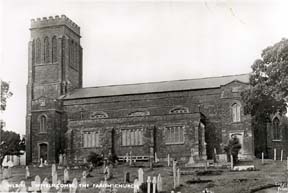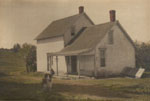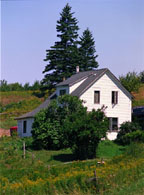|
WILLIAM GAMBLIN was born 1775 in
Wiveliscombe, Somersetshire, England,
and died 1851 in English Settlement, Kings County, New Brunswick, Canada. He married JOANNA STANHOPE SEYMOUR August
27, 1810 in Saint George, East Stonehouse, Devon, England. She was born 1787 in England,
and died 1851 in Pearsonville, New Brunswick, Canada.
|

|
|
Parish Church in
Wiveliscombe, Somersetshire, England
|
William Gamblin was born in
Wiveliscombe, Somersetshire, England. He was apprentice to
a blacksmith. William joined the service on January 3, 1805, at the age of 29, in
Taunton. William got through with a slight sabre cut on one cheek and a bullet wound in
his ankle.
William Gamblin married Joanna (Ann) Seymour in England while in the Royal
Marines, Plymouth Division, in 1810. He was discharged two years later on June 15, 1812,
for a condition called "hectic". At the time, "hectic", was a
medical term for a feverish condition such as tuberculosis ("consumption"), in
which body temperature spikes daily. However, since William lived another 39 years,
he probably did not have TTB or lung cancer.
|

|
|
William and Joanna Gamblin Homestead in
Pearsonville, NB,
pictured in 1900 |
Malaria would have been described as a
"relapsing" fever, so it wan't that either. They emigrated to Canada, and
finally settled in English Settlement Queens County NB. According to John Smith's
Ancestry.com discussion group posting of 11 April 1999, William and Joanna Gamblin came to
New Brunswick, Canada, when it was a wilderness in 1819 from Plymouth Dock, Devonshire,
England with children John, William and Sarah.
Sarah, the youngest, was born in
1818. Joanna picked the bullet out of his ankle years after in New Brunswick on the
old homestead. William and Joanna's homstead still exists in Pearsonville on Highfield
Road in August, 2001. Both are buried in the Woodland United Church Cemetery,
Pearsonville, New Brunswick, Canada.
A 9 March 1892 copy of a
Land Grant
from 9 November 1829 to William Gamblin, John Bartlett, Thomas Harvey, Alexander
Carmichael, James Broad, and William Pearson is in the possession of Ken and Susan
Barbi,
Annapolis, Maryland, in February 2001.
In the on-line parish register from Stoke Damerel Parish, William Gamblin is referred to as a laborer at Plymouth Dock (later known as Devonport). Plymouth Dock-Stoke Damerel-Plymouth was in practicality all one place, different districts that grew and merged into present-day Plymouth. In those days,
Greg Haley thinks there were only two Anglican Churches: Stoke Damerel and St. George's.
Joanna Elizabeth Gamblin, bapt. 3 April, 1814, Stoke Damerel, Devon, England.
Joanna Gamblin buried 22 October, 1815, age 1 year and seven months, in Stoke Damerel parish.
William Henry Seymour Gamblin, bapt. 18 August, 1816, Stoke Damerel, Devon, England.
Source: E Mail from Greg Haley dated May 2, 2008. |
An alternative background for William and Joanna has been
proposed by family members
and included in research done by Colonel Frederick H. Mills in July,1950.
|

|
|
William and Joanna
Gamblin Homestead in August 2001
|
William
Gamblin fought at the Battle of Traflagar in 1805, and Joanna Seymour was a daughter
of a Nobleman - - a direct descendant from the family of which Jane Seymour, wife of King
Henry VIII, was an illustrious member, and whose brother was her progenitor.
William Gamblin was a sailor by profession, a member of England's majestic Navy. He ran
away from home and joined the British Navy or Army with two pals (both of
whom were shot soon after) at age 18 (about 1793) and served between 7 and
8 years (until about 1801). He distinguished himself by his heroic conduct at the Battle
of Trafalgar, under the command of Lord Nelson on October 21, 1805. He was one of the men
on board the HMS Victory when Lord Nelson was wounded and fell on the tiller-ropes and
helped carry Lord Nelson down to his cabin where he died. Later he joined the British Army
and served in it between 7 and 8 years (until about 1809).
The Battle of Trafalgar was a naval battle fought on October 21, 1805, by a British
fleet and a combined French and Spanish fleet. It is one of the most celebrated naval
engagements in European history. The battle took place off Cape Trafalgar on the southern
coast of Spain, pitting a British fleet of 27 ships under the command of Admiral Horatio
Nelson against a slightly larger combined fleet of France and Spain, commanded by Vice
Admiral Pierre Charles de Villeneuve of France. The French admiral was under orders from
Napoleon I to slip out of Cádiz, Spain, which was under British blockade, to land troops
in southern Italy, where the French were fighting. Leaving port on October 19 and 20,
Villeneuve's fleet was intercepted by Nelson's fleet on the morning of October 21.
Villeneuve formed his ships into a single battle line, south to north. Nelson, however,
surprised his adversary by ordering his ships into two groups, each of which assaulted and
cut through the French fleet at right angles, demolishing the battle line; this bold
strategy created confusion, giving the British fleet an advantage. The battle began
shortly before noon; when it ended, in the late afternoon, some 20 French and Spanish
ships had been destroyed or captured, while not a single British vessel was lost.
Villeneuve himself was taken prisoner, along with thousands of his sailors. The British
suffered about 1500 casualties, among them Admiral Nelson, who was mortally wounded. The
overwhelming British victory destroyed Napoleon's plan to invade England and helped secure
the supremacy of British naval forces for the rest of the 1800s.
William Gamblin married Joanna (Ann) Seymour while in the army in 1810. Joanna Seymour
was a daughter of a Nobleman, and a direct descendant from the family of which Jane
Seymour, wife of King Henry VIII, was an illustrious member, and whose brother was her
progenitor. Joanna Seymour's father and family disinherited and also disowned her, as they
considered that she had run away from her family to marry William Gamblin, considered a
common sailor, an inferior, and against their wishes and commands. They emigrated to
Canada, and finally settled in English Settlement Queens County NB. According to John
Smith's Ancestry.com discussion group posting of 11 April 1999, William and Joanna Gamblin
came to New Brunswick, Canada, in 1819 from Plymouth Dock, Devonshire, England with
children John, William and Sarah. Sarah, the youngest, was born in 1818. |